It is a present position.
- Home
- Our Strengths
- Core Technology
Main text is as follows.
Core Technology
We will achieve manufacturing which can only possible by MinebeaMitsumi as an Electro Mechanics Solutions™ Provider contributing for the IoT era by combining Minebea's ultra-precision machining and Mitsumi's electronic technologies.
Research on the latest materials is essential to produce new products for the latest market needs. Minebea researches the characteristics of various materials and uses them for product development to respond to diversified product applications.
-
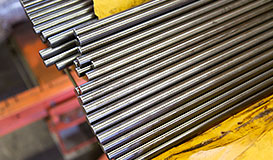
Bearing steel
Composition, crystal structure, impurity and hardness of bearing steel directly affect bearing performance and characteristics. Mainly, we use high carbon chromium bearing steel and corrosion-resistant martensitic stainless steel for long-life bearing steel exposed to severe, extreme pressure of 1000 MPa or more.
-
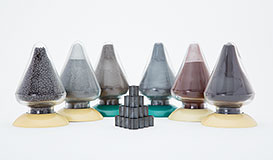
Magnetic material
Minebea is particular about materials in developing ideal products. We select magnetic powder for various applications to manufacture magnets internally. This is our commitment to materialize high-performance products.
-
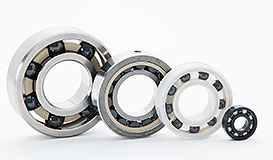
Ceramics
Ceramics' hardness is twice that of bearing steel, its specific gravity is half and its conductivity is zero. Using ceramic balls prevents galvanic corrosion caused by inner bearing energization and improves durability by smaller centrifugal force at high-speed rotation.
machining
Manufacturing all kinds of parts from machined components to electronic parts require advanced machining technology. Precision cutting, machining and molding of various materials makes it possible to fabricate and produce complex products.
-
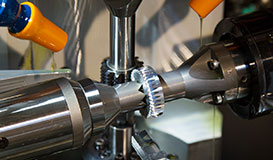
Ultra-precision machining
Advanced machined products such as bearings, rod ends and motors require precision, submicron cutting, grinding and polishing. Our accumulated ultra-precision machining technology realizes fine part machining.
-
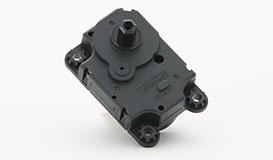
Resin molding
Minebea designs and provides part molds based on advanced designing, using different types of resins according to the application. One of our strength is large-scale global production of precision resin injection-molded parts using our own molds.
-
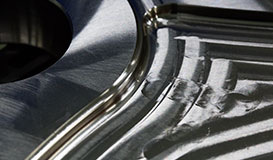
Difficult machining
Our accumulated know-how allows us to flexibly machine difficult materials such as titanium and heat-resistant alloy. Our machining technology can produce products even if most suitable materials for a specific application are difficult to machine.
Measurement
Various data analyses are necessary for the development of quality products. Minebea customizes and develops new products with its advanced analysis and measurement technologies, using accumulated know-how.
-
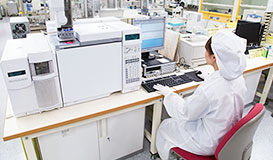
Precision measurement
We maintain and improve quality by internally measuring ultra-precision parts and chemical substances that affect material quality and the environment.
-
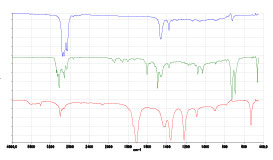
Cleanliness analysis
Minebea developed eco-friendly part cleaning technology in the early '90s and totally abolished the use of a specific CFC in 1993. We have set up internal chemical analysis testing equipment for detailed monitoring to maintain and control cleanliness.
-
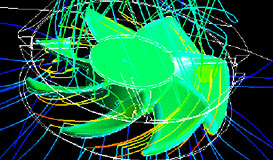
Fluid (dynamic pressure) analysis
Fluid analysis technology is necessary for the development of parts such as bearings and fans that operate in fluid (oil) and gas (air). Thorough simulation of fluid and gas movement and pressure to reproduce and understand phenomena allows more accurate feedback to design.
Other analysis/measurement technology
- Electromagnetic emission (ECM)
- Vibration analysis
- Thermal analysis
process
Stable supply of quality precision parts, the strength of Minebea, is supported by plants all over the world. Global facility investment strategy realizes a production process that maximizes the group's comprehensive strength.
-
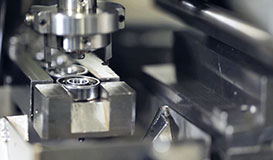
Automatic assembly
Large-scale automatic assembly lines for mass production of major production are developed and produced in our mother plants in Karuizawa, Hamamatsu, Fujisawa and Yonago. The lines are globally introduced to group plants as unique precision and efficient production lines.
-
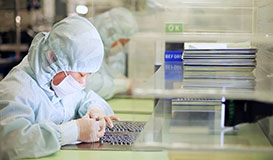
Clean room
Quality of precision products such as ball bearings, backlights and HDD parts is highly dependent on air dust. Large-scale clean rooms are provided in plants for their production, assembly and inspection.
-
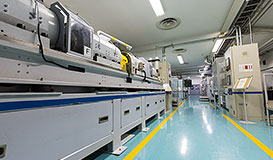
Reliability design/evaluation
We repeat thorough reliability tests for precision aerospace parts and other parts where lasting and stable performance is required. Testing equipment reproduces various use environments to ensure design and production reliability.
Other production process technology
- Cleaning
- Heat treatment
- Aluminum casting
- Electrical/mechanical connection
- Circuit printing
- Electronic parts packaging
- Technology transfer
- Environmental compliance
Magnetic technology is essential for the development and production of power electronics products such as motors. Minebea internally handles the processes from magnet material preparation to molding and sintering, and produces magnetizing coils to maximize a magnet's performance.
-
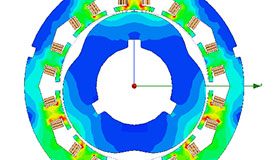
Electromagnetic designing
Detailed magnetic field analyses help find optimal solutions for mechanical parts and magnetic materials. They maximize motor accuracy and capability and enhance the accuracy of hybrid motors and resolvers.
-
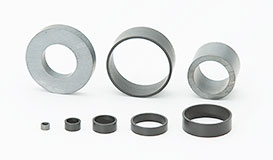
Magnet molding
Motor magnets are internally molded, sintered and painted based on years of magnetic material research. Efficient magnets are installed on our products.
-
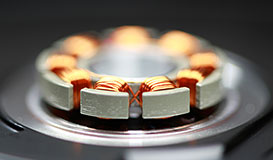
Magnetization
We internally produce magnetizing coils for a magnetization process that directly affects motor performance. We design and manufacture magnetizing coils to exert maximum energy on efficient magnets, and this helps to manufacture high-performance motors.
electronics
Power electronics technology supports efficient rotating devices and electronic parts. Minebea handles efficient power circuit designing, board mounting and precision coil winding.
-
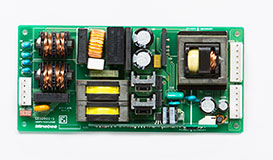
Power circuit (power conversion)
Since the '80s, we have developed and produced power transformers and PC/LCD TV and projector power supplies. Utilizing these power circuit designing technologies, we develop and produce efficient power supply drive circuits for LED lighting.
-
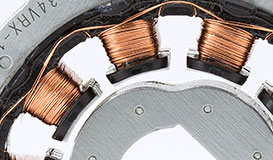
Coil winding
Coil winding technology directly affects the performance and productivity of motors and angle sensors. Minebea's optimal winding equipment jointly materialized with partner winding machine makers helps to speed up processes and stabilize manufacturing.
-
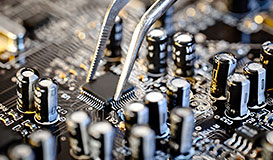
Board mounting
Efficient and quality board mounting technology is essential for the commercialization of power conversion circuits. Superior circuit designs cannot be commercialized unless they are applicable to an actual board design. The feasibility of customer required design and applicability to board design are the keys for mounting.
By combining technologies of Minebea's load sensors/magnetomerters and Mitsumi's sensors, we will further reinforce sensing device products which is an essential device for IoT.
-
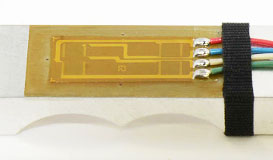
Strain gauge (elastic body)
A force applied to an elastic body is measured accurately from the signal of a strain gauge attached to the elastic body. Strain gauge material and grid shape are designed considering higher accuracy and fatigue resistance. Strain gauges are used for static strain measurement where stability is required and dynamic strain measurement where fatigue resistance is required.
-
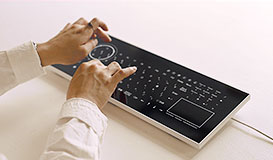
Strain Gauge Type Vector Sensor
This is a small and lightweight vector sensor that detects the translation power in three directions. Our core technology and advantages of a strain gauge are fully utilized in this product.This is used for FA equipment and inner force sense devices such as robotics and others.
-
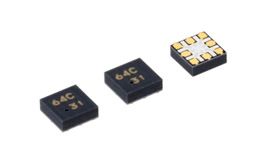
Pressure Sensors
Piezoresistance is formed inside sensors using MEMS technology, and the resistance value varies with pressure. By reading this resistance value, fluctuations in air pressure can be measured.
This device is expected to be used as air pressure sensor to detect atmospheric pressure and altitude being built into smartphones and drones, as well as be used to measure pulse wave as pressure gauging sensor which is incorporated into a blood pressure monitor.
element
Composite products made of machined parts and electronic parts require machine element technology that realizes complex designs. Our TRDC (Tokyo Research and Development Center) develops new products by combining Minebea's machined parts and electronic parts.
-
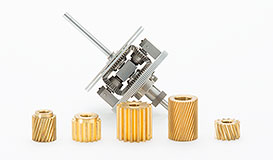
Gear
Gears that transmit power are the key to advanced designing. Minebea manufactures gear parts from various materials (iron, plastic, nonferrous metal) based on optimal designs.
-
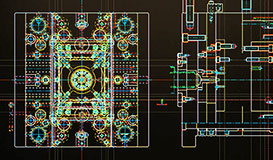
Mechanical designing
Elaborate designs and precision parts are necessary for efficient mechanisms. Minebea designs products and produces their necessary parts internally.
-
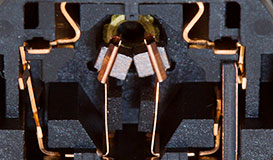
Brush (commutator)
We produce small, light, high-torque, low-noise, low-cogging and long-life brush motors by selecting the optimal brush (commutator) materials and carrying out precise designing.
Optical technology supports mobile device LCDs, LED lenses and other optical products. Thorough simulation-based optical part designing and ultra-precision machining technology for design embodiment are utilized in product manufacturing.
-
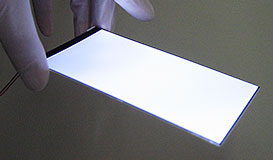
Optical guide plate designing
Optical guide plate requires design technology that allows uniform light emission across a thin-plate surface. Besides this technology, Minebea utilizes injection molding technology, fine mold machining technology and design-based injection molding technology to produce the world's thinnest optical guide plates.
-
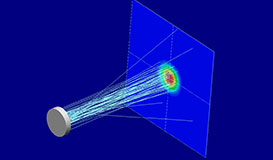
Lens designing
Various designs are required according to the lighting lens application. Detailed simulation of light behavior makes it possible to design ultra-thin optical guide lights and develop new LED lighting lenses.
-
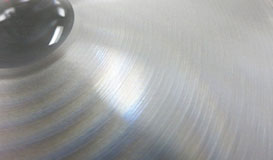
Micro-optical element designing
To efficiently control light with a thin lens, technology of micro-optical element designing is necessary. All elements including light collection, dispersion, reflection and refraction are considered for designing, based on optical simulation technology.
(lubrication)
Tribology (lubrication) technology is necessary to reduce friction resistance, abrasion and seizure. Our know-how in lubricants accumulated over half a century allows us to design lubrication according to product application.
-
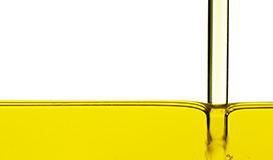
Oil
Oil is a liquid lubricant, made of base oil and additives. Shape characteristic of liquid (low viscosity) provides high versatility and low friction resistance, which makes it suitable for lubricating parts that rotate at high speed.
-
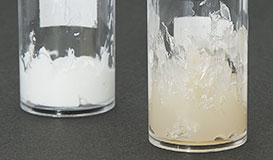
Grease
Grease is a semisolid or solid lubricant, made of liquid lubricant and dispersed thickener. Being less prone to aging, it is generally used as a lubricant for long-life products.
-
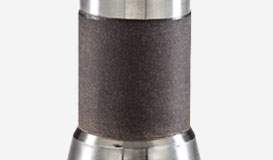
Lubricating liner
A new-type lubricant, lubricating liner has a self-lubricating property and does not need periodic lubrication. Various liners are used according to the application, such as liners with abrasion resistance and insulating property and stick slip-proof liners with low torque.
Coating
Advanced product development requires surface treatment and thin film-forming technologies. Our thin film/coating technology developed internally supports the development of products that have been impossible.
-
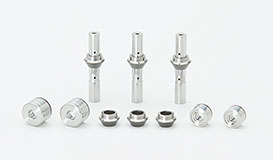
Superhard thin film forming (DLC)
Application of thin film/DLC coating secures long-time lubrication between metallic parts. This method provides materials with different characteristics and realizes high reliability.
-
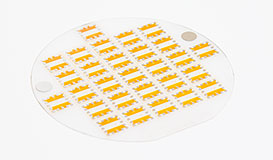
Functional thin film forming (SOS)
SOS (Silicon on sapphire) is a technology where a silicon film is formed (epitaxial growth) on a sapphire (single-crystal AI2O3) substrate. This silicon semiconductor strain gauge atomically combines with the sapphire substrate to create physically and electrically stable and ideal sensors.
-
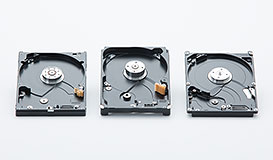
Surface treatment (E-coat)
Surface of aluminum die cast parts are E-coated with ions of opposite polarity for corrosion- and abrasion-prevention, and form uniform coating.
These devices integrating electrical and mechanical elements are produced by microfabrication using semi-conductor manufacturing technology and ion beams, facilitating the mass-production of miniaturized, reduced power consumption products.
-
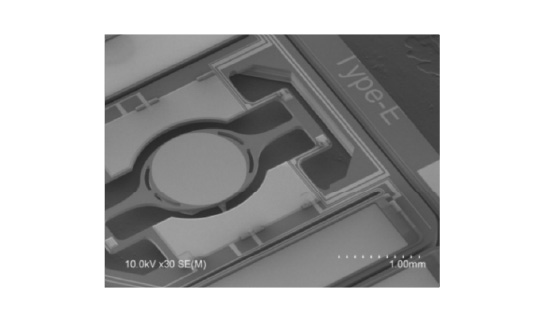
MEMS actuators
These are minute actuators to which a piezoelectric thin film is applied as the driving source, and are produced by deep etching a silicon substrate to form a beam structure with width and thickness of approximately 70 μm and 40 μm, respectively.
The above photo features a device equipped with high-reflectance mirror and deflection angle sensor, is capable of two-dimensional laser scanning. Such devices are used in laser projector image display devices, and can be found in heads-up displays (HUD) and head-mounted displays (HMD), etc. -
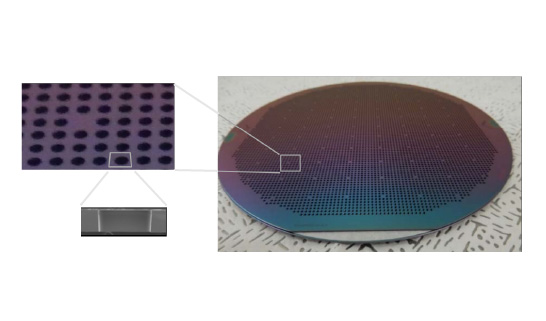
MEMS sensors
These sensors are produced by deep etching a silicon substrate to form a diaphragm (drum) structure with thickness of 10 μm or less, and are used to detect stress applied to and deviations in the diaphragm by arranging piezoresistive elements.
Issues such as drift characteristics existed with the conventional piezoresistive method, however, process improvements have now led to high-performance sensors.
(Simulation)
Analysis
Analysis technology is the fundamental technology which supports product development, the manufacturing process, and product evaluation, etc., and is indispensable to the creation of new technology.
At MITSUMI, we use CAE to simulate structural analysis such as strength and vibration analysis, resin flow analysis, and press machining analysis to develop high-performance products.
-
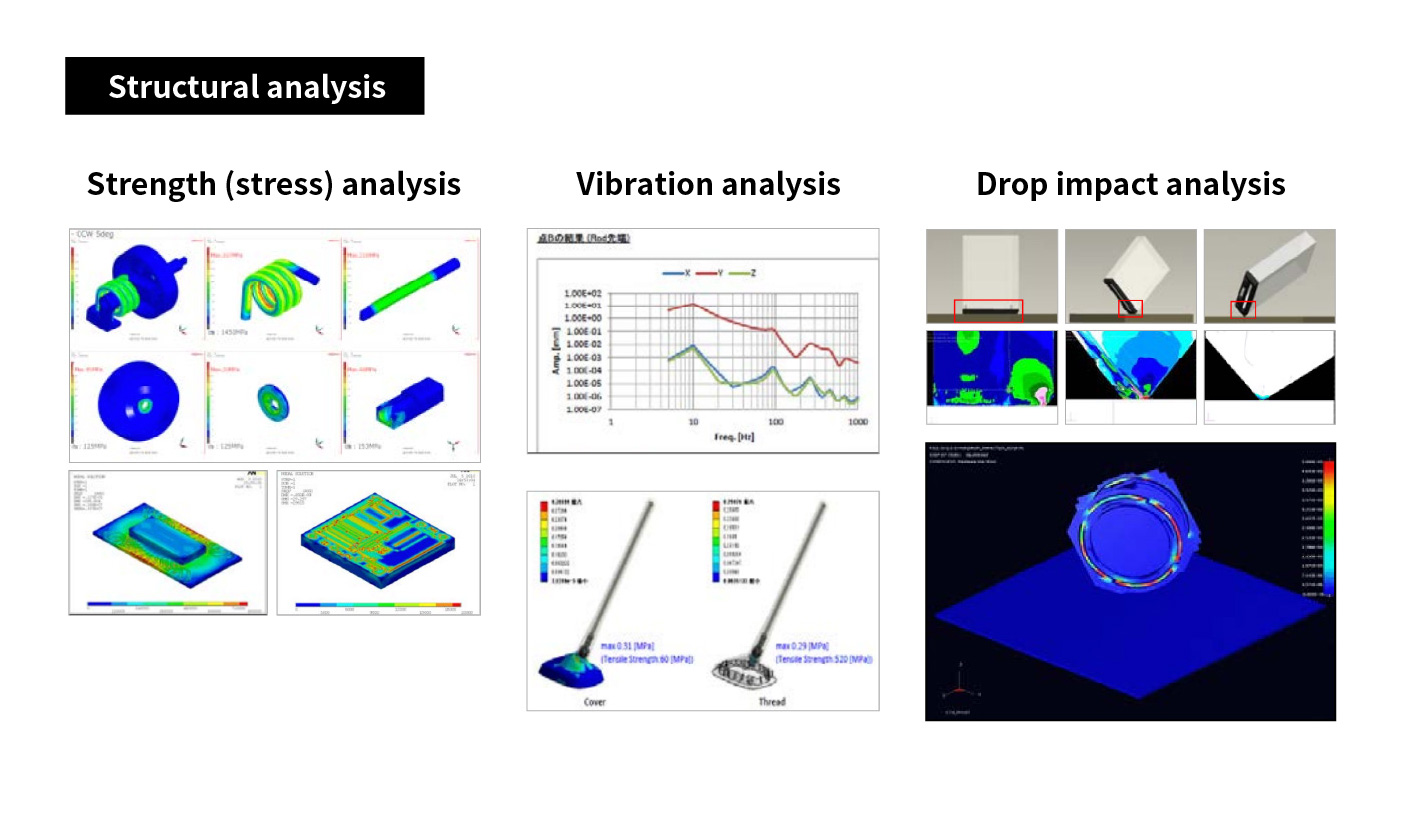
Structural analysis
Structural simulation allows resonance phenomena to be verified by stress evaluation and vibrations, and drop impact stress to be evaluated. Through this, strength can be evaluated beforehand.
By conducting such simulations, the development period can be shortened. -
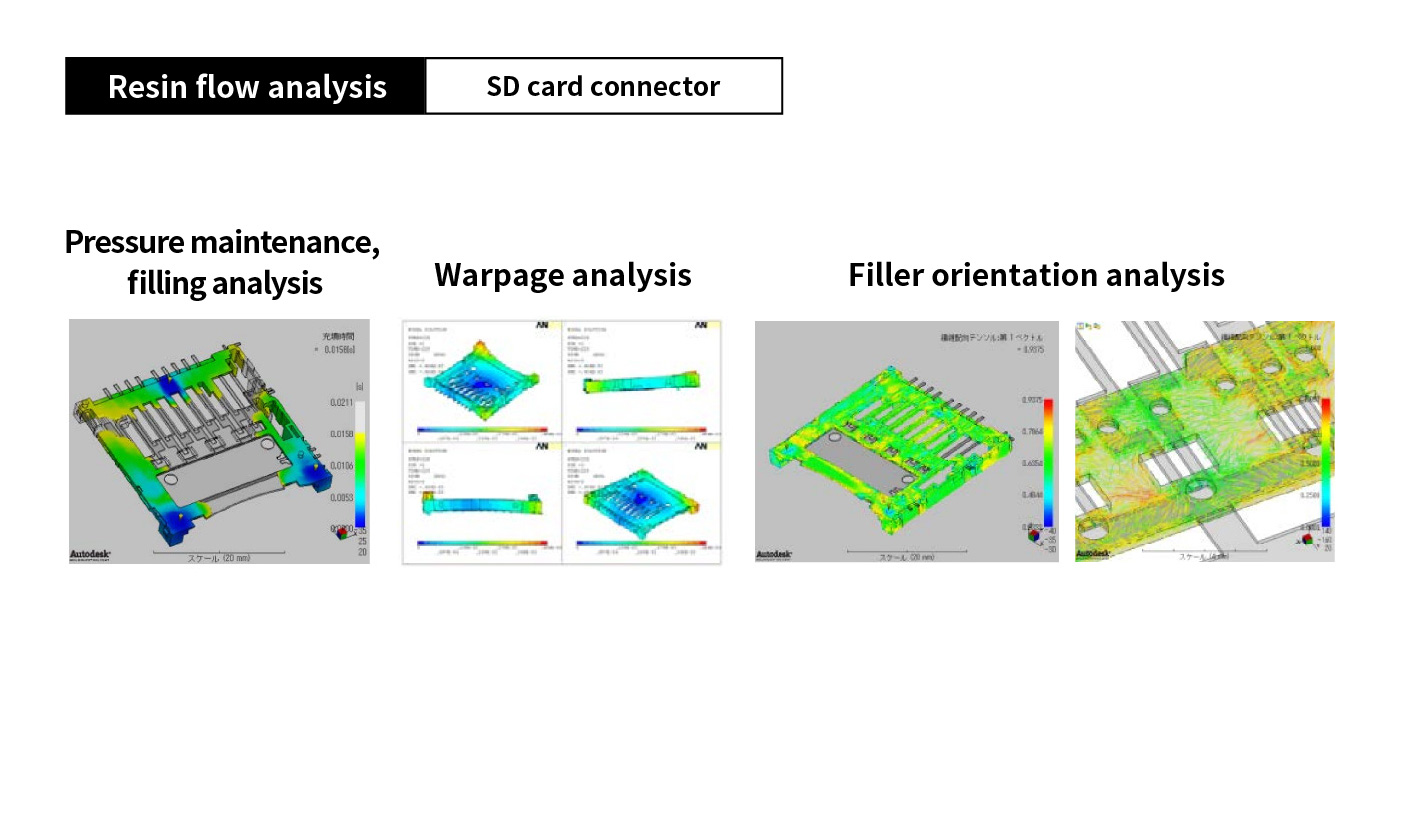
Resin flow analysis
Many resin parts are used in electronic devices and components. Using the above simulation, it is possible to view how resin is poured into molds in the manufacturing process, allowing the optimum manufacturing process to be constructed. Furthermore, this simulation allows performance such as product shape stability and strength to be improved. The above results are for a thin SD card Connector.
-
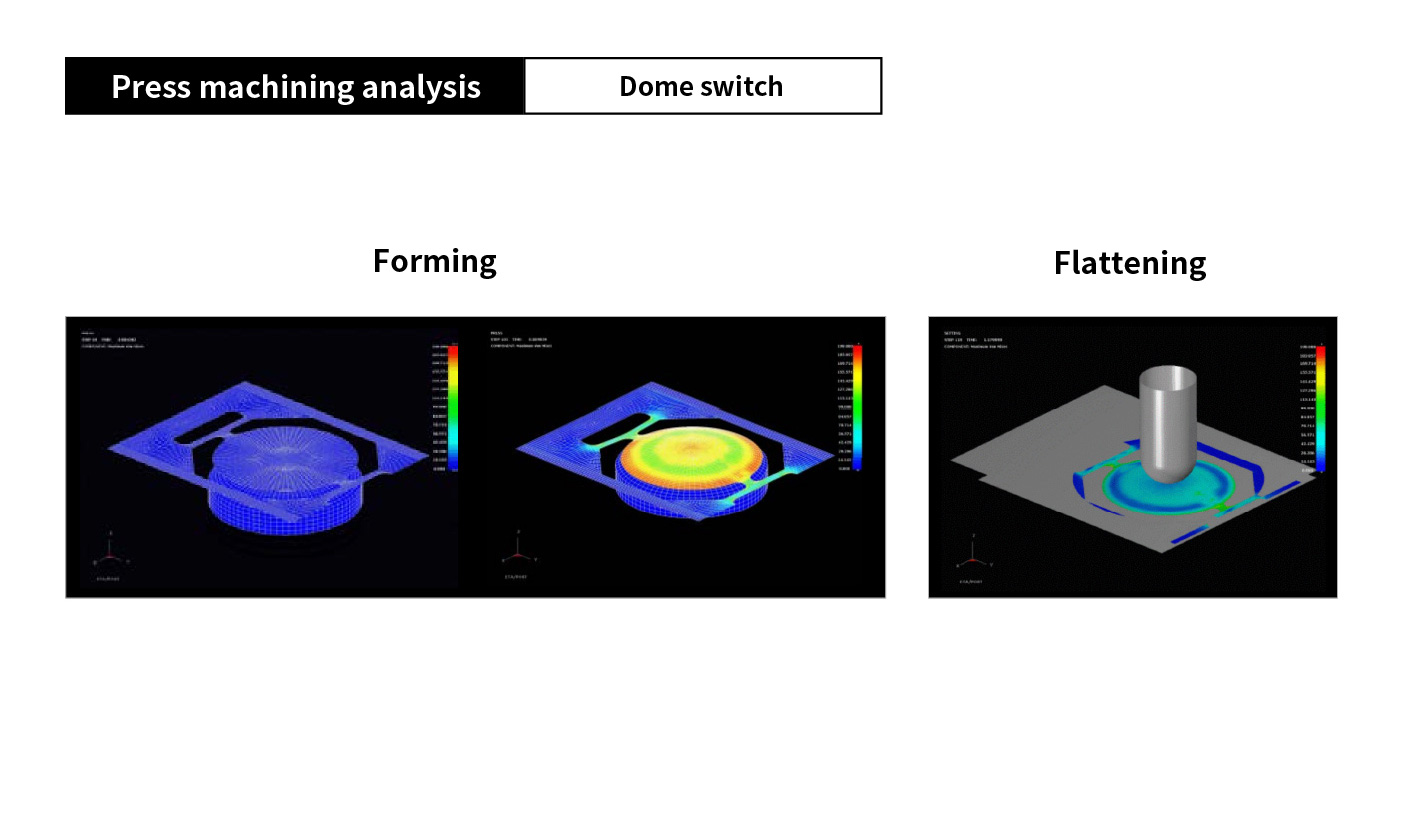
Press machining analysis
Electronic devices and components also contain many press machined parts. Using CAE, actual formability can be verified at the computer. By doing so, cracks, folds, and spring back, etc. can be evaluated beforehand. The above press machining is used for switches used in smartphones, etc. The optimum click feel is realized using this analysis technology.
(Antenna)
MITSUMI provides high-accuracy antennas based on our high technical strength in antenna simulation technology in wide bandwidth ranging from AM waves to millimeter waves, and amplifier circuit design.
-
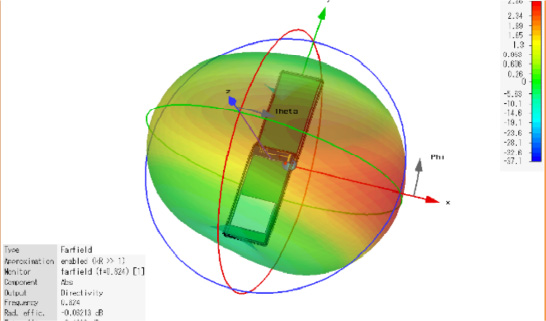
Antenna design technology
For many years, MITSUMI has continued to design antennas compatible with new communication technologies.
We have incorporated antenna technology suited to a variety of applications in response to the demands of the times, and are engaged in efficient design utilizing simulators. -
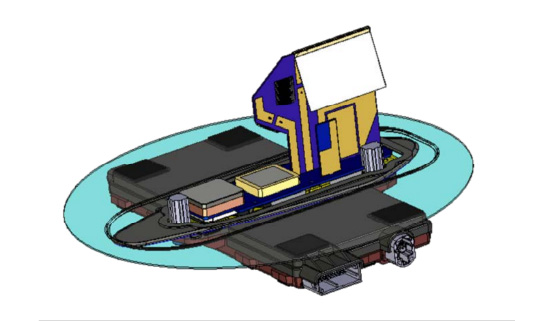
Compound technology
In recent years, an increasing number of media has given rise to strengthening trends in compound antennas, their integration with tuners, and miniaturization. MITSUMI proposes and provides a variety of compound products.
-
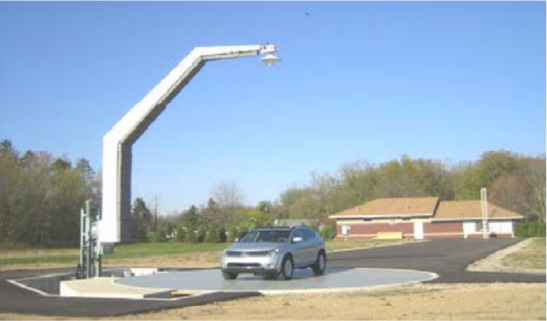
Evaluation technology
Characteristics for various antennas, from those built into compact devices to vehicle-mounted antennas, can be evaluated using MITSUMI's own evaluation facilities.
(Communication))
With our many years of experience in high frequency circuit technology and high-level communication quality evaluation technology used for antenna and communication module optimization, MITSUMI is able to propose reliability and high performance communication modules which have been supplied to various markets.
-
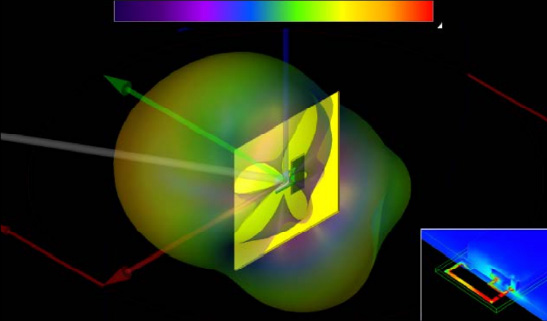
Wireless technology
For many years, MITSUMI has been engaged in the design and manufacture of high frequency products, and we have technological strength and enough experience in high frequency product design. Furthermore, we are also able to design antennas, and carry out processes from simulation to measurement in house. By combining high frequency product design technology and antenna technology, we have succeeded in producing high-performance wireless device products.
-
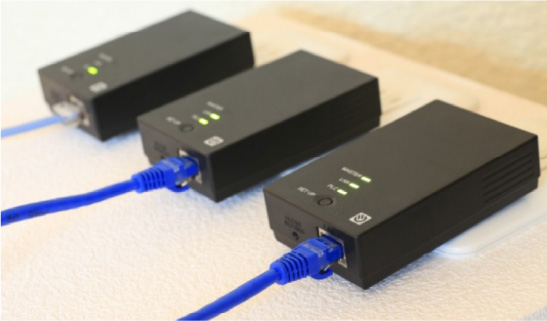
Wired technology
In addition to wireless communication, systems capable of constructing communication networks with wires and cables can also be realized. PLC (*) technology is able to utilize power lines and existing coaxial lines laid in households, buildings, and factories, etc. as communication lines. Furthermore, this technology is also expected to play an active part in the IoT field as technology capable of establishing long-distance, broad-range networks.
※PLC:Power Line Communication -
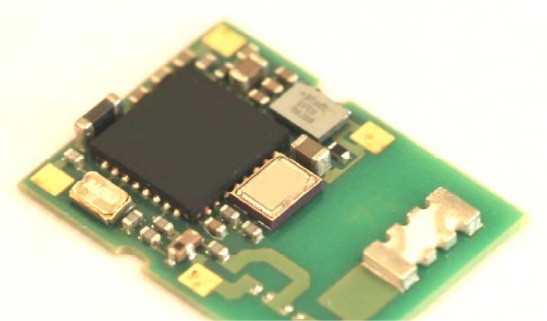
Surface-mount technology
In modern society, the rapid development of digital information technology has led to demands for compact and high functional communication modules . To respond to these requirements, high-density surface-mount technology is essential. MITSUMI uses surface-mount technology developed over many years to continuously pursue even further communication module miniaturization and high component density.
(Batteries)
These module technologies ensure battery safty in all fields, from protective circuits for small capacity batteries such as those used in wearable devices, to battery management systems for large capacity batteries such as storage batteries.
-
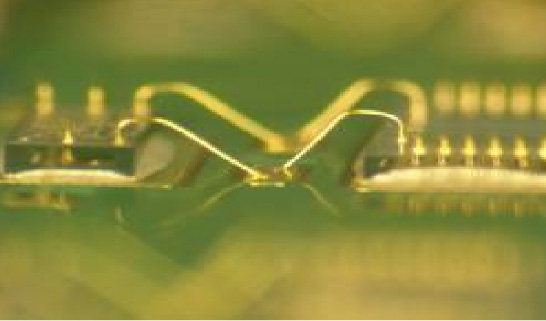
COB surface-mount technology
Chips produced in-house such as battery protector ICs and MOSFETs for circuit breaking are mounted directly onto substrates, and connected with wire bonding. Furthermore, we integrate with other component and print resin on the substrate in the vacuum state. Thus COB surface-mount technology is a module manufacturing technology to integrate. Manufacturing is carried out in a clean room, ensuring high product reliability.
-
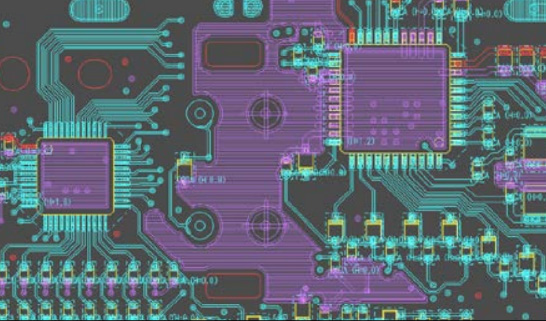
Substrate design technology
Module substrates for batteries require unique design technology such as part arrangement taking rated current, ESD, electrolyte resistance, and part stress due to substrate deformation into consideration. By designing substrates in house using MITSUMI's accumulated know-how, we are able to provide highly safe substrates speedily.
※ESD:Electro Static Discharge -
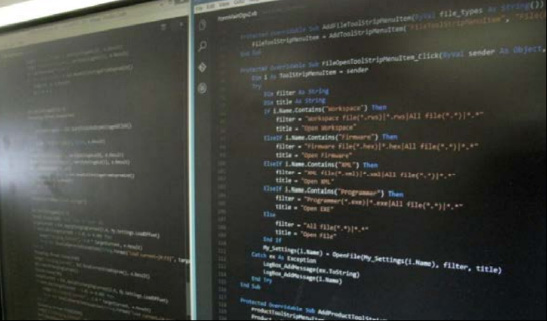
Inspection technology
MITSUMI supports the automation of dedicated F/W writing based on required specifications, all types of calibration, and all types of measurement with our own software and automatic measurement machinery. Furthermore, the communication method can be selected, and we can perform inspection in accordance with the required specifications.
※F/W:Firmware
Design
(Actuators)
Magnetic‐drive systems are adopted in the majority of actuators for camera modules mounted in mobile devices.
High-performance products are realized with high-level CAE and ultra-small mechanism design technology.
-
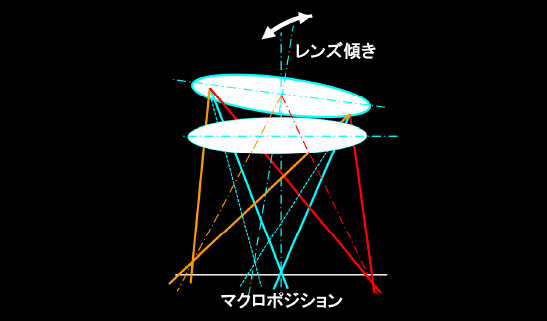
Ultra-small mechanism design
The key feature of actuators is that lens are moved vertically moved vertically, without tilting, when lens are moved by autofocus.
Ultra-small mechanisms are realized through precision spring design and part tolerance analysis. -
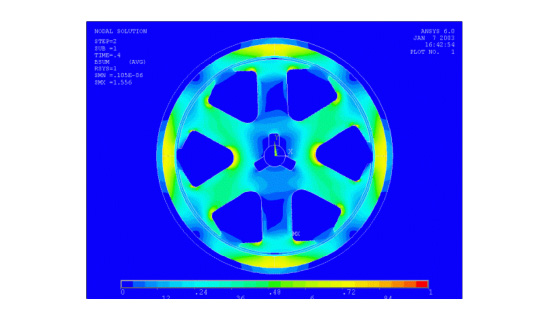
Magnetic field analysis
To realize compact, low-profile actuators, highly efficient magnetic circuits are required. High-efficiency actuators are realized by conducting high-precision magnetic field analysis, and optimizing magnetic circuits.
-
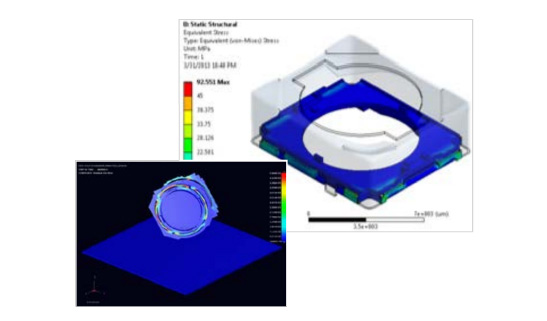
Impact/stress simulation
One aspect of reliability required of actuators is drop resistance.
Highly reliable products are released within a short time-frame by conducting high-level impact/stress simulations.
Design
(Camera Modules)
Smartphones and tablets are equipped with high-resolution, compact and thin camera modules which need to have High-accurancy assembly and image evalution technologies.
-
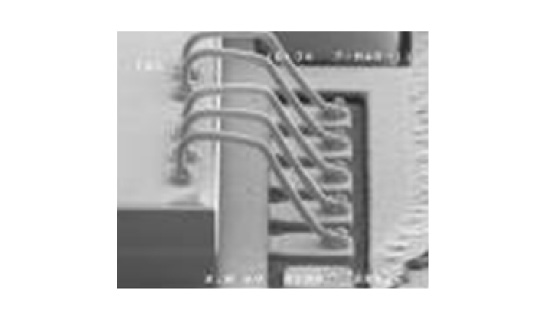
COB surface-mount technology
This technology involves mounting image sensors directly onto printed circuit boards and wire bonding them. It is important to set conditions (load, power, time, temperature, ultrasonic energy) for ensuring wire connection reliability with printed circuit boards and sensors.
-
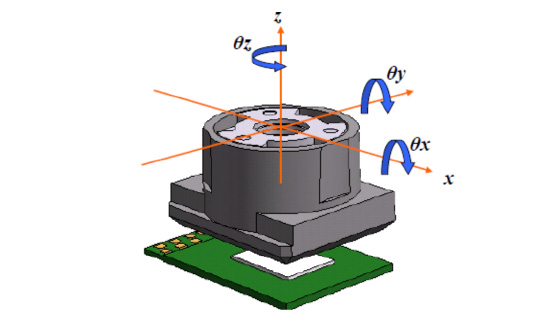
Active alignment
The alignment of optical components and sensors is a vital element in ensuring superior image quality. Lens units are adjusted in 6 axes (X, Y, Z, θ) on the sensor substrate and we have established such assembly technology to realize optimum quality.
-
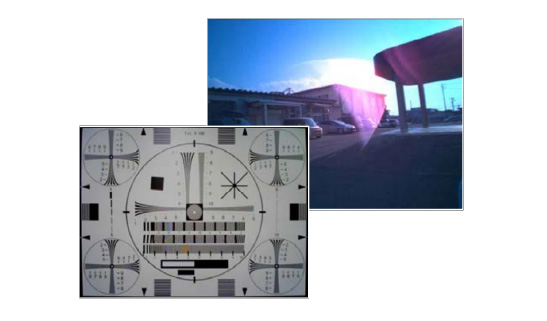
Optical evaluation/evaluation technology
In order to take beautiful images, the lens is the most important component of the camera module. The "resolution", as well as unintentional "ghosts and flares" that occur due to complex reflection inside the lens are evaluated.
Design
This is a group of devices utilizing analog technology to realize high accuracy, low noise, and low power consumption. We can choose CMOS or Bipolar process technology for the most suitable products in accordance with the application.
-
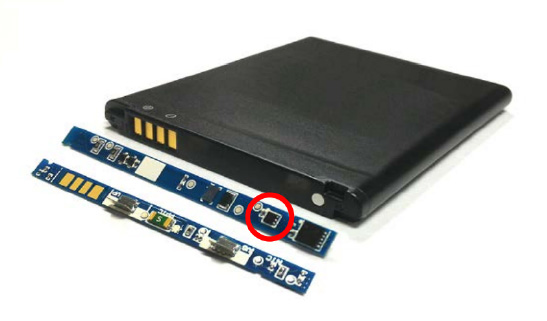
Protector ICs for Li-ion secondary batteries
These ICs are necessary for Li-ion secondary battery packs, an indispensable component of mobile products.
Following the launch of Li-ion secondary batteries in the latter half of the 1990s, MITSUMI has forged ahead with development and mass production.
By harnessing our deep technology and experience, MITSUMI has been contributing to battery pack safety and peace of mind with our rich product lineup and high-accuracy voltage and current detection technologies. -
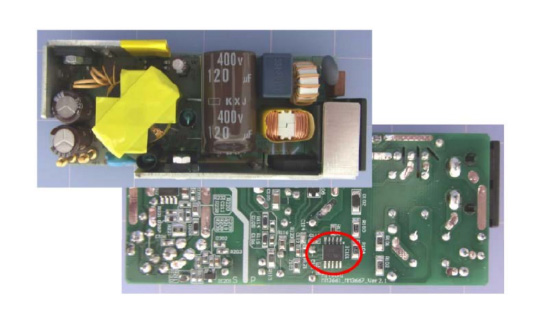
Power supply ICs
MITSUMI has an enough experience in high-accuracy, low-noise, and high-efficiency design technologies obtained through the development of series regulator, DC/DC converter, and custom power management ICs.
Our AC/DC converter ICs have been adopted for MITSUMI's own power supply products, and enable us to propose various applications.
Today we have top share in the system reset ICs as the first manufacture to introduce such product into market. -
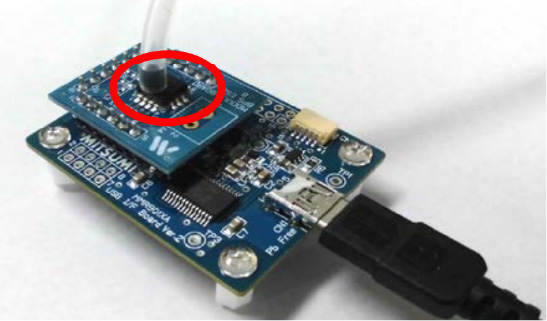
Sensor ICs
MITSUMI has Sensor ICs using core technologies such as MEMS, photodetectors, AD converters, and low-noise amplifiers, etc.
Our MEMS pressure sensor ICs used for blood-pressure monitors, altitude determination and barometry, optical ICs capable of infrared LED detection and ambient light measurement, and mixed signal ICs used for the arithmetic processing of weak signals such as magnetism and thermocouples are used in a broad range of fields such as the industrial, housing, and mobile sectors.
technology
For locking system, taking advantage of our know-how, we have built multiple responses against various threats toward car access, and keep on developing innovative product to counter the progression of burglar kit that we constantly survey.
We are proud to provide products which do not simply satisfy international regulations but as well obtain noteworthy high score through Thatcham Certification.
-
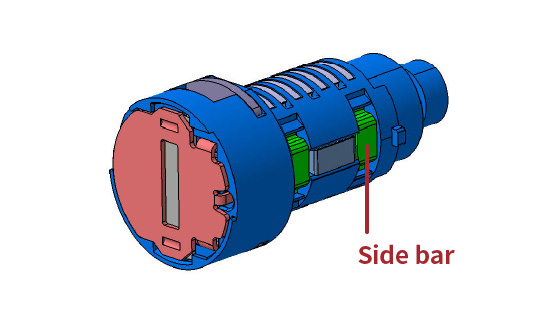
Measures against picking
A “side bar” structure is adopted to the cylinder, which makes impossible to unlock by picking.
This structure is currently adopted also for house door since picking crimes became popular. -
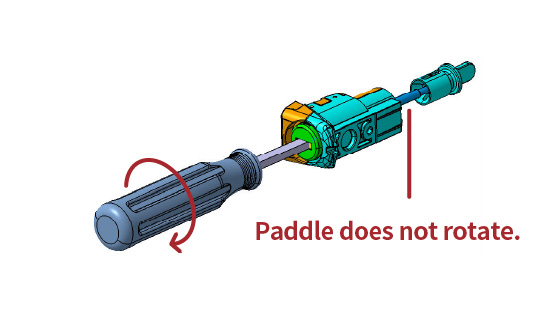
Measures against forced rotation of cylinder by tools
A “freewheel mechanism” is adopted, by which the internal parts remain idle in absence of proper key.
-
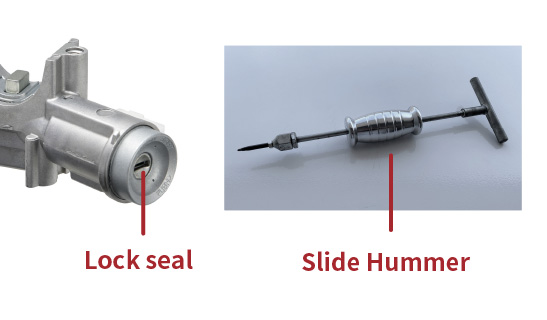
Measures preventing unlocking by forcibly removing the cylinder
A "dead lock strategy" is adopted, that maintain the lock shaft protruding in lock position. Also a high hardness iron part called "lock seal" is adopted in the key insertion area.
-
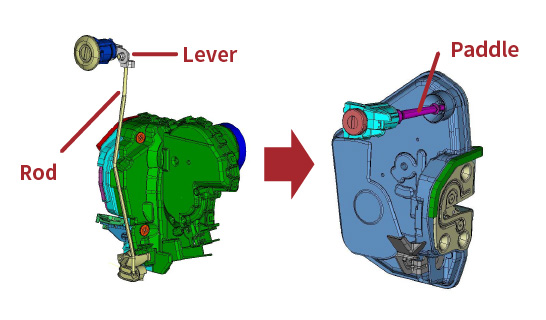
Paddle connection
We succeeded in preventing unlocking of the side door latch inserting a tool in a gap between the door panel and window glass. To do so, cylinder to latch connection was changed from lever + rod mechanism to direct paddle link.
-
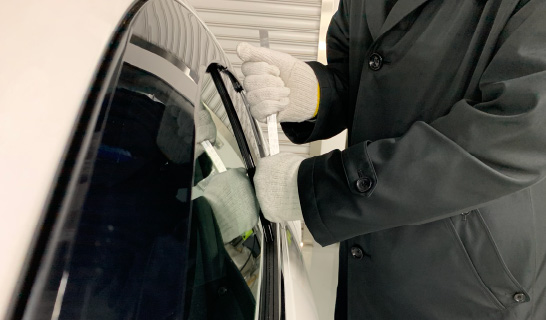
Super lock
To reinforce the lock state of the latch, an additional super lock mechanism is applied making impossible the unlocking even from the vehicle room without proper key.
production system
All the process from development to production and assembly are performed in-house, including molding and painting, allowing us to answer flexibly to all the requested customer needs while maintaining the best constant quality.
-
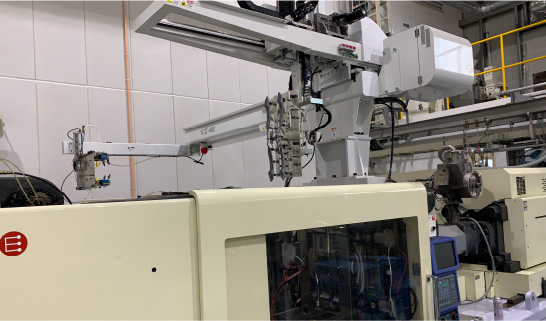
Resin molding
The color of the resin material is selected according to the color of the paint, for high finish quality.
Handles are discharged to prevent foreign matter adhesion and boxed automatically to supply the painting pretreatment process. -
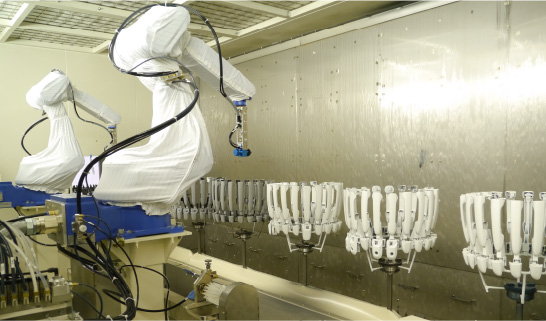
Painting
To improve finish quality, handles are automatically cleaned to remove foreign substances before painting.
The paint colors are frequently switched according production planning to reduce stock and Be as close as possible to customer planning. The "spindle coating method" adopted at our factory benefit of high efficiency realizing high quality coating. -
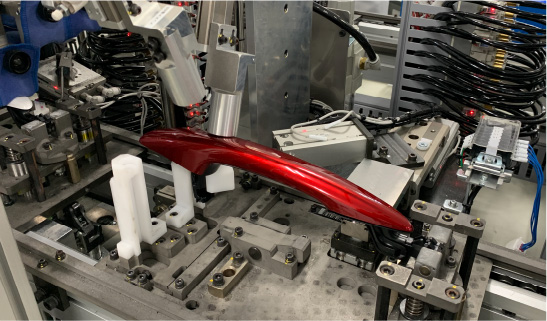
Assembly
Our production system execute automatically assembly according to customer's production sequence (vehicle color & required function).
Appropriate handles are picked, supplied to the assembly line, and assembled automatically.
technology
Mastering fundamental mechanic and electronics based technologies we have now the confidence to focus on developing products which are more convenient, more comfortable and exciting to satisfy the User.
To demonstrate it, we offer Flush Handle technology which consist in a panel-integrated handle, flush with its surface, and actuated to welcome the user. But also an e-Handle system which allows door opening with the lighter operation feeling.
-
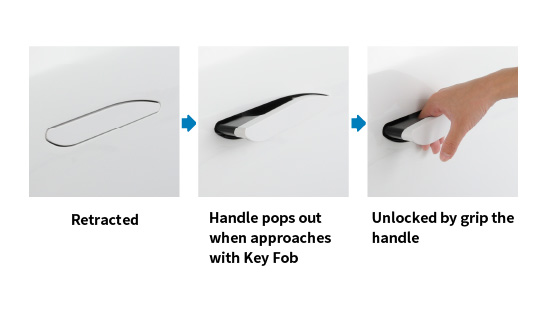
Flush Handle
Handle grip is normally flush with the door panel. It pops out, driven by an actuator, till a position where it can be grasped by the user, while it is housed again during vehicle driving.
In addition to the stylish appearance, this is improving aerodynamic performance and diminish wind noise. -
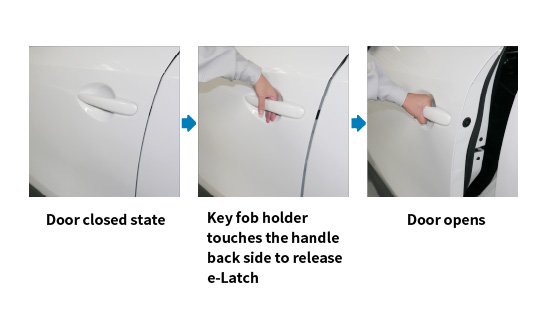
e-Handle system
A vehicle access system consisting of a built-in touch sensor e-Handle working in tandem with Cinching e-Latch for convenient car access.
When key fob holder touches the handle back side, door unlocks by e-Latch release, allowing opening with minimal effort.
Would the door happens to be only half-latched, the cinch-in function will be automatically driven to complete secured closure.
development
technology
Mastering fundamental mechanic and electronics based technologies we are now confident in providing complex systems involving the smart weaving of our portfolio.
As an illustration, we have developed and are manufacturing all the components (drive unit, power rear gate latch, ECU) of the "power rear gate system", a system that opens and closes the rear gate electrically in response to switches or sensors signals.
-
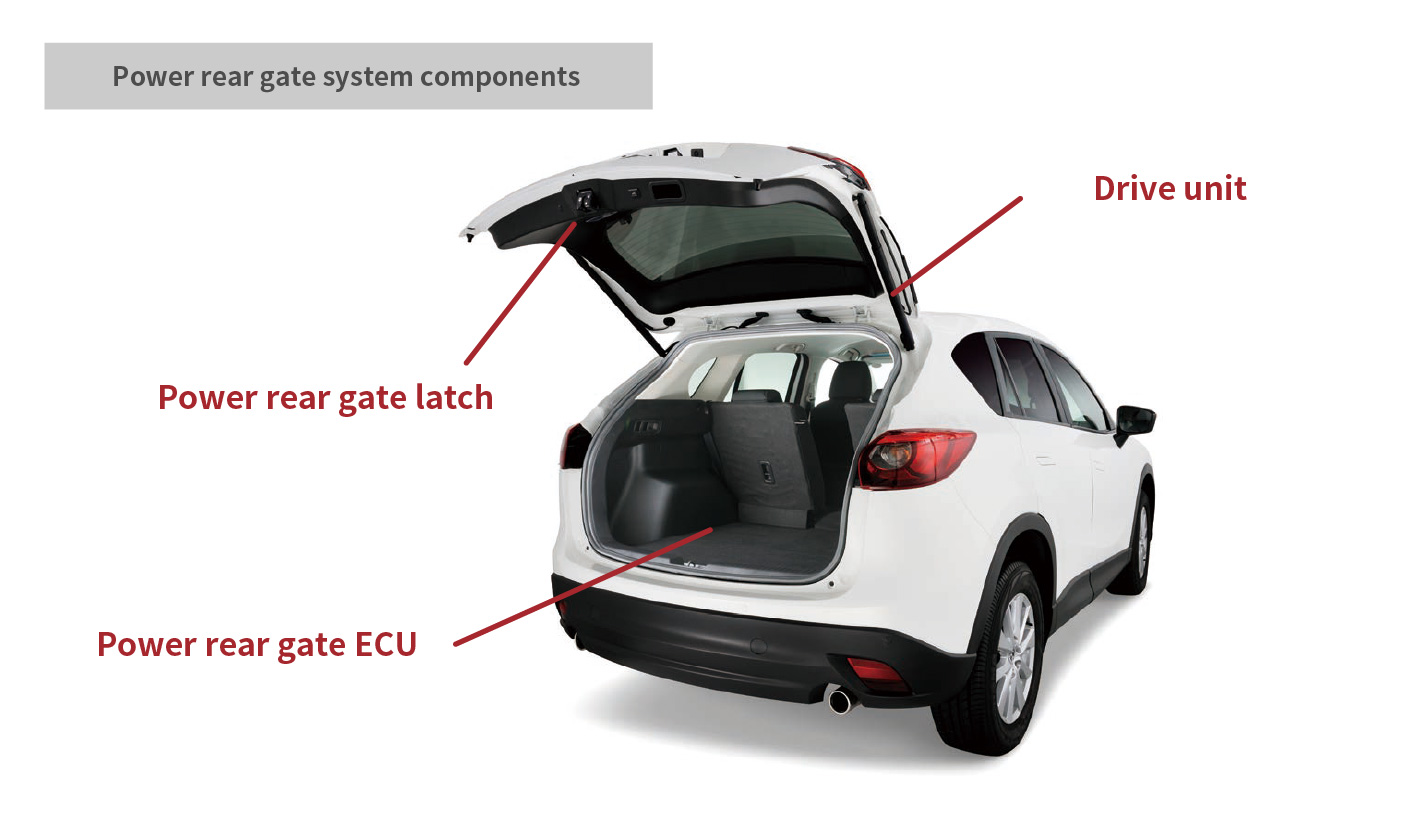
Drive unit
This motorized unit drives the rear gate opening and closing. By the use of plastic material for housing, Diameter and Weight has been reduced for a flexible layout in the vehicle.
-
Power rear gate latch
Door release & cinch-in operation are actuated with a single-motor allowing to optimize product size & weight.
-
Power rear gate ECU
Through model-based development we control the speed of the rear gate as well as the safety by preventing pinching, meeting functional safety requirement.
-
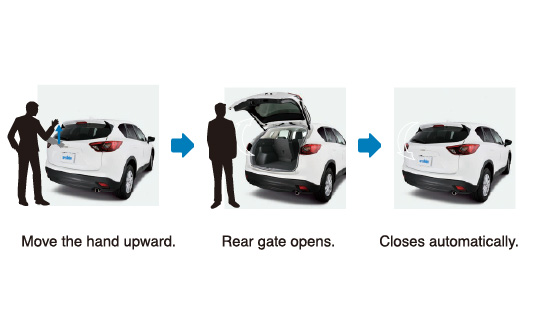
Gesture sensor
The power rear gate system is triggered by detecting human contactless gestures with a gesture sensor.
-
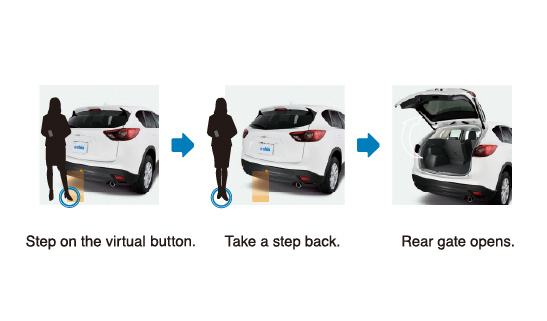
StepGate
The power rear gate system is also triggered by detecting human touchless foot movement with a ultrasonic sensor.
We can provide a theft-proof system, with good operation feeling, and an optimal layout for easy mount. The door Locking-Opening system we offer includes door handles, door lock cylinder, and door latches. The whole architecture could be proposed with diverse level of automation.
-
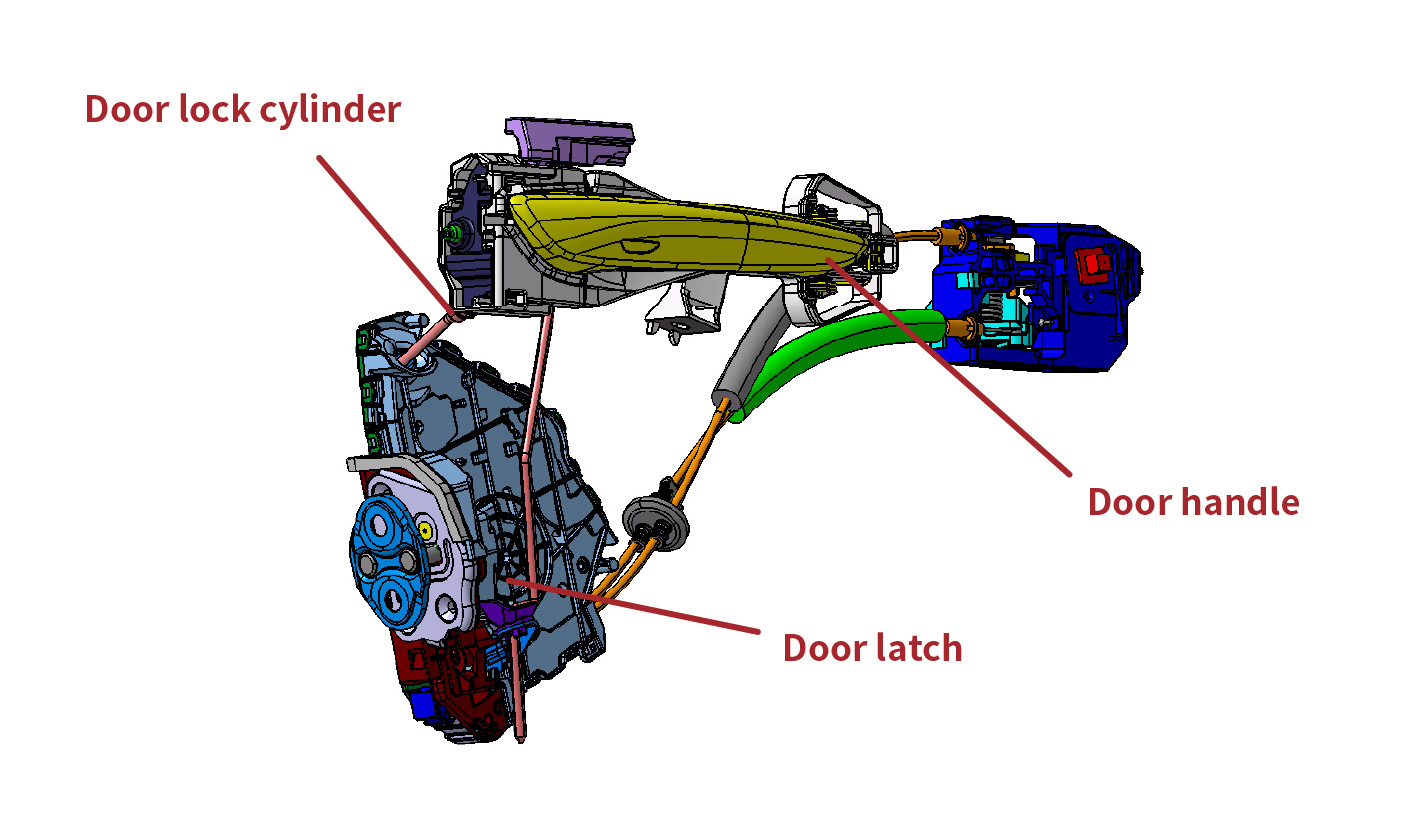
Door handle
Targeting the best exterior design but guaranteeing product functions & performance, U-Shin get involved from early stage of vehicle development discussions and jointly study layouts of door handles & door lock cylinders.
Development period regarding complete system is shortened as interface with the door latch can be optimized in-house. -
Door lock cylinder
Its layout needs to be considered in combination with door handle, considering theft resistance and assemblability on the vehicle.
The relative position to the door latch, which varies for each vehicle, is easily adjusted with minimal parts change. -
Door Latch
We provide a door latch that can be used as a standard product by adapting the lever stroke compatible with various handle strokes while considering customer design trend and proposing flexible connection between door lock cylinder and cable mounting direction.
weight reduction
Our global effort to improve fuel efficiency of the vehicle is driven by reducing parts weight switching from metal to resin when possible but as well optimizing the geometry based on strength simulation.
In addition, downsizing the product enhances freedom for its positioning, which allows flexible vehicle design.
-
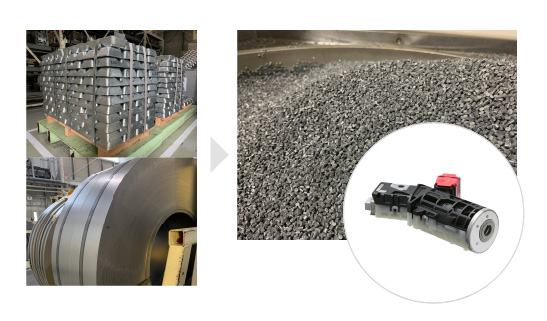
Replacing metal with resin
One of our achievement in weight reduction by replacing conventional metal with resin is the steering lock shown above which has been successfully converted to resin since April 2014 hence reduced weight by approximately 40% compared to conventional one.
-
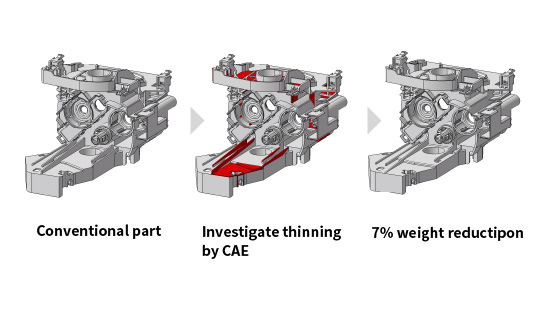
Topology optimization
We propose an optimized product layout obtained thanks to CAE expertize.
Following heater control panel bracket illustrate it by a success of 7% weight reduction compared to conventional one through wall thickness optimization. -
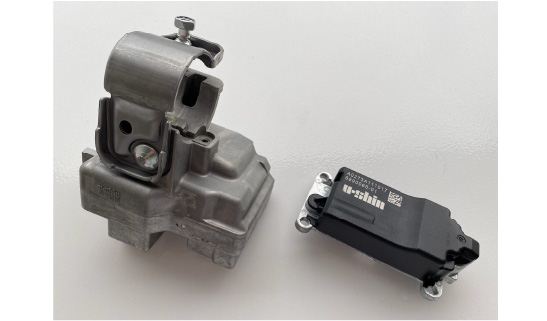
Downsizing
As an example of product downsizing, the following product was the world's thinnest electric steering column lock at SOP in June 2017, while keeping satisfying ASIL-D functional safety requirement.
We are developing various safety technologies to protect occupants in the event of a car collision.
-
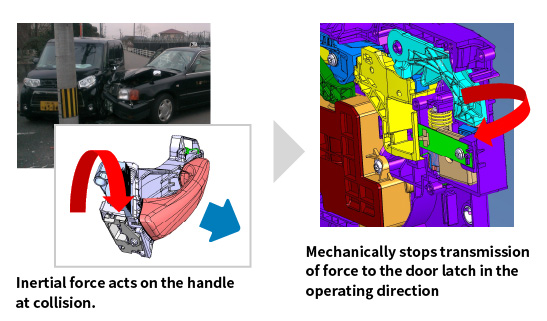
Inertia lock
this mechanism prevent the handle motion in the opening direction during a car crash so that door does not open due to the impact.
-
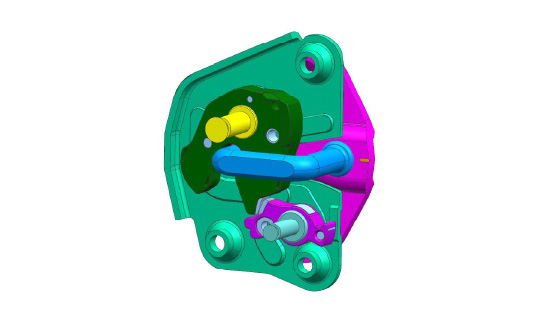
Door opening prevention strength
In order to prevent the door latch from being disengaged and the door accidentally opened in the event of car accident, U-Shin's door latch withstands effort up to 200~250% of the strength required by law for occupant safety.
-
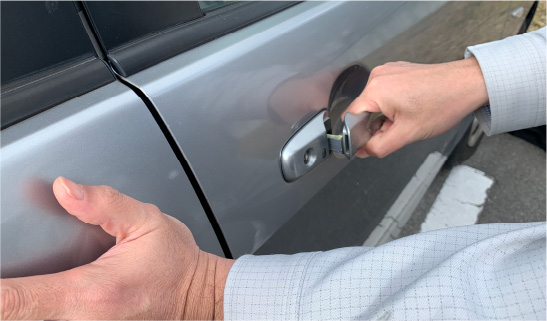
Tensile strength of handles
Enough strength is provided to the outside door handles to prevent damage or injury to the user when operating with abnormal force or when a child hangs in the handle or due to weather conditions such as freezing.
safety design
We develop systems, hardware and software that comply with functional safety standards (ISO26262 and ASPICE) to reduce risks that our products' functions and operation may harm humans, properties, or the environment, to an acceptable level.
In the future, we will further contribute to functional safety by conforming the standard specification for in-vehicle software "AUTOSAR".
-
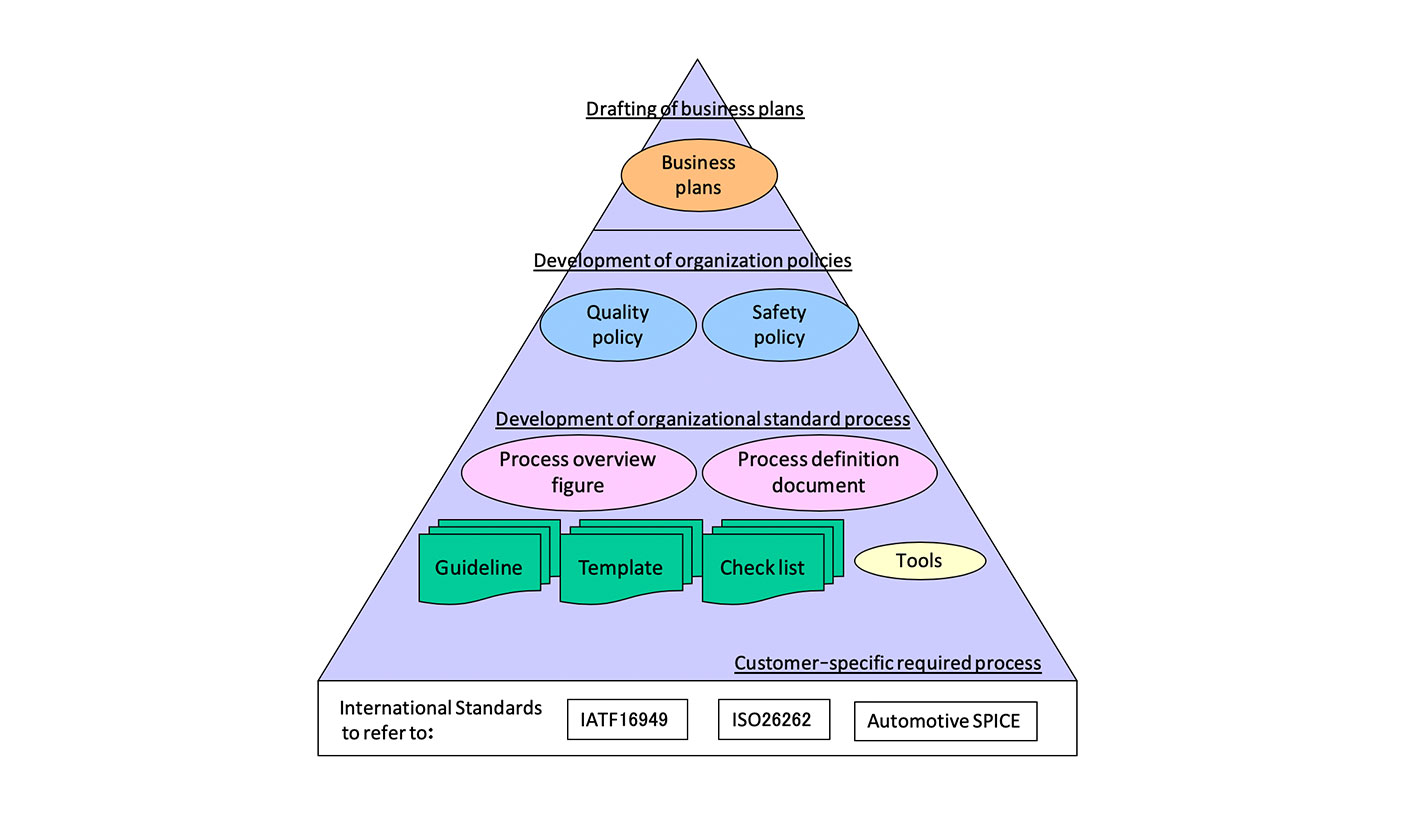
Functional safety design
The steering column lock device (ESCL) for vehicle theft prevention has a functional safety design that prevents the steering wheel from locking during driving. Also, the power lift gate ECU has a functional safety design that prevents the rear gate from unintentionally opening and closing.
It ends about main text.









